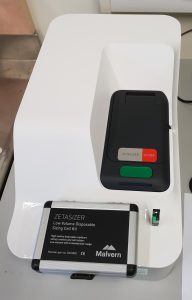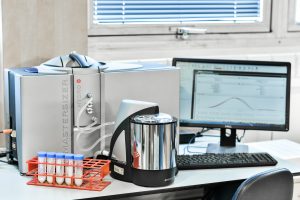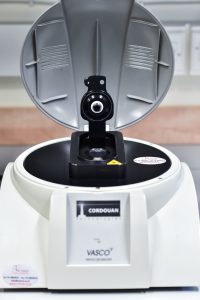Particles size analyzers
Particle size and Zeta potential analyzers based on dynamic light scattering DLS
Dynamic Light Scattering DLS is used to measure particle and molecule size.
The short-term intensity fluctuations (dynamics) of the scattered light arise from the fact that the scattering particles are undergoing rapid thermal motions. These movements are called Brownian motion and they cause short term fluctuations in the intensity of the scattered light. This technique measures the diffusion of particles moving under this Brownian motion, and converts this to size and a size distribution using the Stokes-Einstein relationship. Non-Invasive Back Scatter technology (NIBS) is incorporated to give the highest sensitivity simultaneously with the highest size and concentration range.
We operate Vasco (Cordouan) and Zetasizer Ultra (Malvern) that can be used to determine particle size distribution in the range of few nanometers to few microns in relatively concentrated solutions.
Vasco – Particle size analyzer
The Vasco can measure particles from 2nm up to 6µm, in Dark/Opaque dispersions/emulsions, up to 40%V solids (and even more as long as we have Brownian Motion) with no need of dilution , setting sample temperature 15°c-70°c , The sample volume is only ~75µl and the system has no consumables.
The system can measure precisely several size populations (with Pade’ La’place algorithm) in addition to the common Cumulant algorithm which exists in other particle sizing.
Zetasizer Ultra – Particle size analyzer and Zeta potential measurement
Our center has the new Zetasizer Ultra of Malvern that is advanced system for the measurement of particle and molecular size, particle charge (zeta potential) and particle concentration.
It also offers two unique measurement capabilities: Multi-Angle Dynamic Light Scattering (MADLS®) and Particle Concentration.
The Zetasizer Ultra is a combination of DLS and ELS system, incorporating Non-Invasive Back Scatter (NIBS) and, uniquely, Multi-Angle Dynamic Light Scattering (MADLS 173°, 13°, 90° ) technology for the measurement of particle and molecular size. NIBS provides the versatility and sensitivity to measure over a wide concentration range, while MADLS permits a higher resolution of size distribution and directly ability for analysis particle concentration.
We have also a special Low Volume Disposable Sizing Cell Kit that Allows low volume (3μL minium sample ) and still high quality size measurements ( 0.3 nm – 10 μm diameter).

Zetasizer Ultra
Zeta potential measurement –
Almost all particulate or macroscopic materials in contact with a liquid acquire an electronic charge on their surfaces. Zeta potential is an important and useful indicator of this charge which can be used to predict and control the stability of colloidal suspensions or emulsions, for example. The greater the zeta potential the more likely the suspension is to be stable because the charged particles repel one another and thus overcome the natural tendency to aggregate. The measurement of zeta potential is often the key to understanding dispersion and aggregation processes in applications as diverse as water purification, ceramic slip casting and the formulation of paints, inks and cosmetics.
Laser Doppler Micro-electrophoresis is used to measure zeta potential. An electric field is applied to a solution of molecules or a dispersion of particles, which then move with a velocity related to their zeta potential. This velocity is measured using a patented laser technique called M3-PALS (Phase analysis Light Scattering). This enables the calculation of electrophoretic mobility and from this the zeta potential and zeta potential distribution.
The Zetasizer Ultra also provides the highest sensitivity zeta potential and electrophoretic mobility measurements using M3-PALS technology
Particle size analyzer based on the laser diffraction technique
Laser diffraction analysis utilizes a diffused laser beam passing through a suspension of particles which is then scattered onto a concentric pattern of photo-detectors. A lens focuses the scattered light onto a detector array. Utilizing an inversion algorithm software calculates a particle size distribution associated with the diffraction pattern.
The center is equipped with a new Mastersizer 3000 (Malvern Instruments Ltd) that provides particle size distribution in the range of 10 nm to 3.5 mm. This instrument is working using Hydro MV sample dispersion unit that is a fully automated for medium volume wet sample dispersion unit.
The Hydro MV is designed for medium volume wet dispersion and is suitable for a very broad range of sample types. In-line sonication promotes the dispersion process while a powerful centrifugal pump prevents sedimentation, ensuring that the entire sample is measured in a bias-free way. Chemically-compatible and automated dispersant delivery of both organic and inorganic dispersants allows optimization of the dispersion process and accelerates analysis.

Mastersizer 3000 laser diffraction technique
